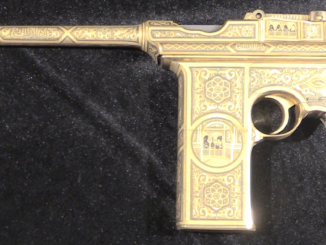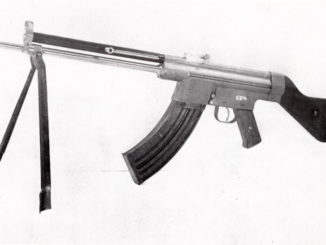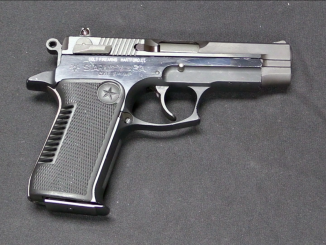Juan Esperanza was one of the two partners who formed the Astra company (with Pedro Unceta). When the two had a falling-out in 1925 and parted ways, Esperanza formed his own company and went on something of a patenting binge. He made an unsuccessful attempt at designing a new machine gun for the Spanish army, and then settled down to make a family of pistols to compete with his former partner’s. These were all called the Ecia Model 1930, and there was a small frame .25 ACP (targeted at the Astra 200 market), a medium frame .32 ACP / .380 ACP (to compete with the Astra 300), and a large frame 9mm Largo model to match up against the Astra 400. The Ecia design was double action, and each size offered a magazine capacity one greater than the comparable Astra. They also have a nicer grip angle, and handle more nicely than the Astra.
Unfortunately for Esperanza, the Spanish military had already adopted the Astra in 1921, and the new Ecia was not sufficiently better to warrant replacing the guns already in service. The pistols were also relatively expensive, and there was minimal civilian interest. Total Ecia production was just 100-150 guns, with each frame size being numbered in a separate series. For more information on the Ecia as well as Astra and other Spanish handguns, I recommend Leonardo Antaris’ reference book “Astra Pistols and Selected Competitors”:




Saw exactly one published article on this make, ever, in a gun magazine of 1970s vintage; was an examination of an example of the .32. Hogg doesn’t mention it in his book at all. I didn’t know there was a .25 or a 9mm. Thanks again for filling in the gaps in our knowledge.
Very interesting, the same “window” on the side is emulated also in Gustloff 507 rifle!
Anybody know some other gun with same feature ?
“Esperanza” is Spanish for “hope”.
Here comes the name for artificial international language
https://en.wikipedia.org/wiki/Esperanto
Little did the developers of Esperanto as a universal and international “lingua franca” suspect that it would be the Japanese “emoji” that truly realized their ambitions?! Ha!
I like the pistols, part of crappy looking tiger bar. They due to their slim profile somewhat resemble Savage
https://en.wikipedia.org/wiki/Savage_Model_1907
Good piece of work overall; never seen it before.
‘Tiger bar’… what a non-sense!
By coincidence, I just look at a semi-documentary about real tiger attack on U.S. army recon team in Vietnamese jungle in 1970.
https://www.youtube.com/watch?v=zpDnlGT3LxY
Double action trigger with manual safety lever plus grip safety… Senior Juan should be a over cautious one… Oh!… Forgot gas vent holes even in .25″ pistol.
The company “Esperanza y Cía” (ECIA) or Esperanza & Co. had no success in pistol making but it excelled in mortar design. Firstly, ECIA produced for Spanish Army 60mm battalion mortar model 1926. It was designed by the captain Vicente Valero de Bernabé. This is an undistinguished design, but latter Valero designed (though It was patented by Esperanza y Cía.in 1933 in France) the 50mm model 1932 company mortar, a light and compact design that was the father of all commando mortars. In 1938 it was adopted by the British Army as 2-inch Mortar Mk I and used in WW2, and latter for many years. Next ECIA-Valero design was an 81mm battalion mortar introduced in 1933, it was based in the Stokes-Brandt design, but it was over complicated. ECIA-Valero mortars were used in the Spanish Civil War. After the war Spanish Army used latter improved versions until company bankruptcy in the 1990s.
The prototype of the .32acp sold for $6000.00 at auction nearly a year ago.
There are some nice pics at the site:
https://www.liveauctioneers.com/item/65311239_s-7-ecia-model-1930-prototype-semi-auto-pistol
Theres also some pics of the .25acp at a spanish site
https://historiadelasarmasdefuego.blogspot.com/search/label/ecia%20modelo%201930